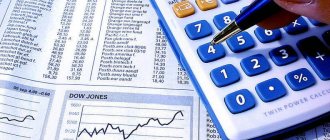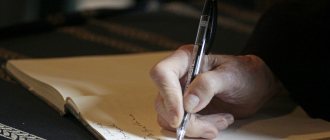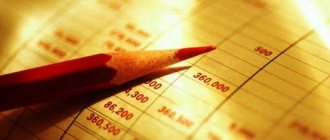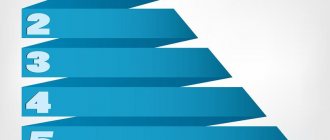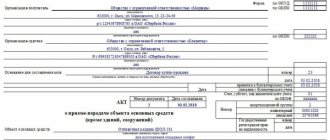How to account for fully depreciated fixed assets
In practice, there are often cases when the initial book value of a fixed asset is completely repaid by depreciation, but the fixed asset itself continues to be used and participates in generating the enterprise’s income.
Find out how to calculate the book value of an enterprise from the article “The book value of fixed assets is...”.
According to the rules of PBU 6/01, it is possible to write off an asset from accounting only if it is disposed of or loses its ability to generate income. If the OS continues to be used, it should continue to be taken into account for accounting purposes and, if necessary, disclose information about it in the financial statements.
Why a certificate of the book value of an organization’s assets is issued, see this material.
Tax authorities adhere to a similar point of view on this issue: if 100% of depreciation has been absorbed for a fixed asset, but it is still in use, it must continue to be taken into account (letter of the Federal Tax Service of Russia dated December 8, 2010 No. 3-3-05/128).
In this case, the residual value of the fixed assets, reflected in the balance sheet and defined as the difference between the initial cost (Dt 01) and depreciation (Kt 02), will be equal to 0.
For more details, see the article “Reflecting fixed assets in the balance sheet” .
In tax accounting
For the purposes of calculating income tax, depreciation deductions can be taken into account as expenses, which will reduce the tax base and reduce the amount of tax.
Depreciation in tax accounting is considered one of two methods: linear and non-linear (Article 259 of the Tax Code of the Russian Federation).
You can read more about the linear accrual method in this article.
The Tax Code allows an organization to independently choose a convenient calculation method. It can be either linear or nonlinear.
The organization has the right to change the non-linear method to a linear one only from the beginning of the year. Moreover, this can be done no more often than once every five years.
Therefore, before choosing a nonlinear method, you should think in advance about the advisability of its use depending on the OS used.
The non-linear accrual method can be applied in tax accounting to all groups of fixed assets, with the exception of:
- immovable objects with a long service life (from 20 years) - buildings, structures from 8-10 depreciation groups;
- transfer devices with long-term SPI - out of 8-10.
Also, the nonlinear method is not used by companies that use fixed assets to produce hydrocarbons in a new offshore field.
Thus, it is advisable to apply the nonlinear calculation method to fixed assets that have a short useful life and change their performance characteristics during use.
It is convenient to write off stable fixed assets that practically do not change during operation using the straight-line method, in which deductions are uniform.
Nuances of calculating property tax on fixed assets with 100% depreciation
To calculate property tax, the residual value of property is included in the tax base (Article 375 of the Tax Code of the Russian Federation).
In this case, it is equal to 0, i.e. there will be no tax to pay. But before depreciation of fixed assets is written off, the organization must include information about them in the declaration or tax calculation of advance payments for property tax (letter of the Federal Tax Service of Russia dated December 8, 2010 No. 3-3-05/128).
ATTENTION! From 2020, movable property is not subject to tax.
Read about all the news related to filling out and submitting a property tax return in the section “Tax return for corporate property tax .
Depreciation period
Accrue depreciation from the 1st day of the month following the month in which the property was put into operation (clause 4 of Article 259 of the Tax Code of the Russian Federation). In the same order, calculate depreciation on capital investments in the form of inseparable improvements to fixed assets received under lease agreements or gratuitous use (loans) (clauses 6, 7 of Article 259.2 of the Tax Code of the Russian Federation).
When depreservation, completion of reconstruction (modernization) of a fixed asset, as well as when returning a fixed asset transferred for free use, depreciation is calculated from the 1st day of the month following the month in which these events occurred (clause 9 of Article 259.2 of the Tax Code of the Russian Federation ).
Accrue depreciation for each depreciation group (subgroup) until its total balance is less than 20,000 rubles. In the month following the one in which this value was achieved (provided that in the next month the total balance of the depreciation group did not increase), the organization has the right to liquidate this depreciation group (subgroup) and write off its residual value as non-operating expenses. This procedure is provided for in paragraph 12 of Article 259.2 of the Tax Code of the Russian Federation.
Repair and modernization of depreciated operating systems
Fully depreciated OS objects may require repair or modernization.
If you are modernizing or reconstructing such facilities, then both in accounting and tax accounting, the costs for it will increase the current value of the object.
In this case, the amount of depreciation accrued in NU for one month should be determined as the product of the initial cost increased as a result of modernization and the depreciation rate determined based on the useful life of this object. That is, it will depend on whether the SPI has increased as a result of modernization or not. If the period remains the same, the norm established when the OS was put into operation is applied. If it has increased, the norm should be revised (see letters of the Ministry of Finance dated September 11, 2018 No. 03-03-06/1/64978, dated October 23, 2018 No. 03-03-06/1/76004, dated October 25, 2016 No. 03-03- 06/1/62131)
Find out about the position of the tax authorities regarding the start of depreciation of the modernized fixed asset from the publication “The Federal Tax Service supported a profitable option for depreciation of the modernized fixed asset.”
For accounting purposes, the organization has the opportunity to choose: extend the useful life of the operating system or leave it the same. The decision is made based on how much time will be used or how much product still needs to be released on this upgraded OS.
For transactions on the modernization of fully depreciated property, see ConsultantPlus. If you don't have access to the system, get a free trial online.
If you are repairing fully depreciated operating systems, then the costs are taken into account immediately in the period in which the repairs were carried out. For tax purposes, these expenses must be taken into account as part of other expenses, and in accounting, repair expenses are classified as expenses for ordinary activities.
Depreciation calculation
To calculate depreciation using the nonlinear method, you need to determine:
1. Total balance of the depreciation group (subgroup). It is defined as the total cost of fixed assets that are included in the same depreciation group (subgroup). When determining the total balance, do not take into account the cost of fixed assets, for which depreciation can only be calculated using the straight-line method.
Initially, determine the size of the total balance on the 1st day of the tax period from which it was decided to apply the non-linear method. Subsequently, the total balance must be determined on the 1st day of each month. It is necessary to take into account that its size will change.
The total balance of the depreciation group (subgroup) may increase:
- when putting into operation new fixed assets included in this depreciation group;
- when the initial cost of fixed assets changes in the event of their completion, additional equipment, reconstruction, modernization, technical re-equipment.
The total balance of the depreciation group (subgroup) may decrease:
- upon disposal of a fixed asset;
- upon partial liquidation of a fixed asset.
In addition, the total balance is reduced monthly by the amount of accrued depreciation for this group of fixed assets for the previous month.
This is stated in paragraphs 2–4, 10 of Article 259.2, paragraph 1 of Article 322 of the Tax Code of the Russian Federation.
Determine the total balance on the 1st day of each month using the formula:
| The total balance of the depreciation group (subgroup) as of the 1st day of the month for which depreciation is calculated | = | Total balance of the depreciation group (subgroup) at the beginning of the previous month | + | Initial cost of fixed assets put into operation in the previous month | + (–) | The amount by which the initial cost of fixed assets increased (decreased) during completion, retrofitting, reconstruction, modernization, technical re-equipment, partial liquidation | – | The amount of accrued depreciation for the previous month (the amount of the residual value of the retired fixed asset) |
This procedure follows from the provisions of paragraphs 3, 4 and 10 of Article 259.2 of the Tax Code of the Russian Federation.
An example of determining the total balance of a depreciation group for calculating depreciation of a fixed asset using the non-linear method in tax accounting
The organization purchased five laptops in January. The cost of one laptop is 110,000 rubles. (without VAT). In accordance with the Classification approved by Decree of the Government of the Russian Federation of January 1, 2002 No. 1, the laptop belongs to the second depreciation group (useful life from two to three years).
The accounting policy for tax purposes determines that for fixed assets included in the second depreciation group, depreciation is calculated using a non-linear method.
As of January 1, the organization did not have fixed assets included in the second depreciation group. Therefore, the total balance of this depreciation group on January 1 is zero.
Laptops were put into operation in January. As of February 1, the total balance of the second depreciation group amounted to 550,000 rubles. (RUB 110,000 × 5 pcs.).
The depreciation rate for the second depreciation group is 8.8 percent.
The amount of accrued depreciation for February amounted to 48,400 rubles. (RUB 550,000 × 8.8%).
In February, the organization purchased another laptop worth RUB 102,000. (without VAT) and put it into operation in the same month.
The total balance of the second depreciation group as of March 1 is equal to: 550,000 rubles. + 102,000 rub. – 48,400 rub. = 603,600 rub.
The amount of accrued depreciation for March was: RUB 603,600. × 8.8% = 53,117 rub.
2. Depreciation rate. The depreciation rates that are applied under the non-linear method are defined in paragraph 5 of Article 259.2 of the Tax Code of the Russian Federation. For each depreciation group, fixed depreciation rates are established, which do not depend on the useful life of fixed assets (as with the straight-line method).
Calculate the monthly depreciation amount using the formula:
| Monthly depreciation amount | = | Total balance of the depreciation group as of the 1st day of the month | × | Depreciation rate for the corresponding depreciation group | : | 100% |
An example of calculating depreciation using the non-linear method in tax accounting
In January, the organization purchased a fixed asset - a laptop at a price of 102,000 rubles. (without VAT). The laptop was put into operation that same month. The accountant determined that, in accordance with the Classification approved by Decree of the Government of the Russian Federation of January 1, 2002 No. 1, the laptop belongs to the second depreciation group (useful life from two to three years). The useful life of the laptop is 36 months. The organization has no other fixed assets included in this depreciation group.
According to the accounting policy, for tax purposes, depreciation on computer equipment is calculated using a non-linear method.
The monthly depreciation rate for fixed assets included in the second depreciation group is 8.8 percent (clause 5 of Article 259.2 of the Tax Code of the Russian Federation).
Every month, the accountant determined the total balance of the depreciation group and the amount of depreciation for this group:
| Month | Total balance of the depreciation group at the end of the month | Amount of accrued depreciation by depreciation group |
| 2016 | ||
| January | 102,000 rub. | 0 rub. |
| February | RUB 93,024 (RUB 102,000 – RUB 8,976) | 8976 rub. (RUB 102,000 × 8.8%) |
| March | RUB 84,838 (RUB 93,024 – RUB 8,186) | 8186 rub. (RUB 93,024 × 8.8%) |
| April | RUR 77,372 (RUB 84,838 – RUB 7,466) | 7466 rub. (RUB 84,838 × 8.8%) |
| May | RUB 70,563 (RUB 77,372 – RUB 6,809) | 6809 rub. (RUB 77,372 × 8.8%) |
| June | RUB 64,353 (RUB 70,563 – RUB 6,210) | 6210 rub. (RUB 70,563 × 8.8%) |
| July | RUB 58,690 (RUB 64,353 – RUB 5,663) | 5663 rub. (RUB 64,353 × 8.8%) |
| August | RUR 53,525 (RUB 58,690 – RUB 5,165) | 5165 rub. (RUB 58,690 × 8.8%) |
| September | RUB 48,815 (RUB 53,525 – RUB 4,710) | 4710 rub. (RUB 53,525 × 8.8%) |
| October | RUB 44,519 (RUB 48,815 – RUB 4,296) | 4296 rub. (RUB 48,815 × 8.8%) |
| November | RUB 40,601 (RUB 44,519 – RUB 3,918) | 3918 rub. (RUB 44,519 × 8.8%) |
| December | RUB 37,028 (RUB 40,601 – RUB 3,573) | 3573 rub. (RUB 40,601 × 8.8%) |
| 2017 | ||
| January | RUB 33,770 (RUB 37,028 – RUB 3,258) | 3258 rub. (RUB 37,028 × 8.8%) |
| February | RUB 30,798 (RUB 33,770 – RUB 2,972) | 2972 rub. (RUB 33,770 × 8.8%) |
| March | RUB 28,088 (RUB 30,798 – RUB 2,710) | 2710 rub. (RUB 30,798 × 8.8%) |
| April | RUB 25,616 (RUB 28,088 – RUB 2,472) | 2472 rub. (RUB 28,088 × 8.8%) |
| May | RUB 23,362 (RUB 25,616 – RUB 2,254) | 2254 rub. (RUB 25,616 × 8.8%) |
| June | RUB 21,306 (RUB 23,362 – RUB 2,056) | 2056 rub. (RUB 23,362 × 8.8%) |
| July | RUB 19,431 (RUB 21,306 – RUB 1,875) | 1875 rub. (RUB 21,306 × 8.8%) |
After 18 months of using the laptop, the total balance dropped below 20,000 rubles. The organization did not put into operation any other fixed assets belonging to the second depreciation group.
In August 2020, the accountant included in non-operating expenses the entire amount of the residual value for this depreciation group in the amount of 19,431 rubles.
Sale and liquidation of fixed assets with a residual value of 0
The sale price of fully depreciated property is the contract price (Article 105.3 of the Civil Code of the Russian Federation). Sold or liquidated fixed assets are deregistered (clause 76 of the Guidelines for accounting for fixed assets, approved by Order of the Ministry of Finance of Russia dated October 13, 2003 No. 91n).
When selling an asset with a residual value of 0, you need to charge VAT on the full sales amount.
Read more about the calculation of VAT on the sale of fixed assets in the article “Calculation and procedure for paying VAT on the sale (sale) of fixed assets.”
For tax purposes, proceeds from the sale of fixed assets are considered as income from sales (clause 1 of Article 249 of the Tax Code of the Russian Federation). Since the residual value of a depreciated fixed asset is 0, income from sales can only be reduced by those costs that are associated with securing a transaction for this fixed asset (clause 1 of Article 268 of the Tax Code of the Russian Federation).
Liquidation expenses for calculating income tax are included in non-operating expenses (clause 1 of Article 265 of the Tax Code of the Russian Federation) at a time in full in the period when they were actually incurred (clause 7 of Article 272 of the Tax Code of the Russian Federation).
There is no need to restore VAT (which was previously accepted for deduction) on a liquidated object with 100% depreciation (Article 170 of the Tax Code of the Russian Federation).
Check whether you have correctly reflected the sale of fully depreciated property with the help of advice from ConsultantPlus. Learn for free with a free trial of the legal system.
Elimination of a depreciation group (subgroup)
When an object of depreciable property is disposed of, the total balance of the depreciation group (subgroup) to which this object was included is reduced by its residual value (clause 10 of Article 259.2 of the Tax Code of the Russian Federation). Sometimes after such a decrease the total balance becomes zero. This occurs if the given depreciation group (subgroup) no longer contains other objects of depreciable property.
If, after reducing the total balance by the residual value of the disposed object, the total balance of the depreciation group (subgroup) is equal to zero, this depreciation group (subgroup) must be liquidated (clause 11 of Article 259.2 of the Tax Code of the Russian Federation).
Clause 12 of Art. 259.2 of the Tax Code of the Russian Federation also provides that a depreciation group can be liquidated if the total balance does not exceed 20,000 rubles. In this case, it does not matter how many objects of depreciable property are still included in this depreciation group (subgroup) and what their residual value is.
The liquidation of such a depreciation group is carried out not in the month in which the specified value is achieved, but only in the following month. If the total balance has not increased in the next month, its balance is written off as non-operating expenses of the current period.
When writing off the total balance, which has become less than 20,000 rubles. the institution does not need to determine the residual value of the objects included in this depreciation group, since it is not their residual value that is subject to a one-time write-off, but the balance of the total balance of the depreciation group or subgroup.
https://www.youtube.com/watch?v=ytcopyrightru
Example 3. An institution uses a non-linear depreciation method. As of February 1, 2009, the total balance of the second depreciation group is equal to 21,000 rubles. The amount of depreciation for February for this depreciation group is 1848 rubles. (RUB 21,000 x 8.8 / 100). The balance of the total balance after depreciation for February is 19,152 rubles. (21,000 - 1848).
In February, the organization did not put into operation new fixed assets belonging to the second depreciation group. Therefore, in March its total balance will not increase. Based on clause 12 of Art. 259.2 of the Tax Code of the Russian Federation, the institution wrote off the balance of the total balance in the amount of 19,152 rubles. included in non-operating expenses.
In accordance with paragraph 13 of Art. 259.2 of the Tax Code of the Russian Federation, upon expiration of the useful life of an object of depreciable property, an institution may exclude this object from the composition of a depreciation group (subgroup) without changing the total balance of this depreciation group (subgroup) on the date of removal of this object of depreciable property from its composition. At the same time, depreciation accrual based on the total balance of this depreciation group (subgroup) continues.
The composition of depreciation groups for calculating depreciation using the non-linear method is determined by the useful lives of fixed assets in accordance with the Classification approved by Decree of the Government of the Russian Federation of January 1, 2002 No. 1. If the procedure for calculating depreciation for fixed assets included in the same depreciation group, varies, within it one or more depreciation subgroups should be distinguished.
For example, this should be done if part of the fixed assets with the same useful life is operated in an aggressive environment and depreciation on them is charged with an increasing factor (subclause 1, clause 1, article 259.3 of the Tax Code of the Russian Federation). Or if the organization uses certain fixed assets (except for buildings and structures) exclusively for R&D (clause 13 of Article 258 of the Tax Code of the Russian Federation).
Donation of a fully depreciated OS object
Donation of property worth over 3,000 rubles. between two commercial organizations is prohibited by law (Article 575 of the Civil Code of the Russian Federation).
For details of gratuitous agreements between legal entities, see here.
Since there is no separate procedure for determining the price of an asset with a zero book value transferred as a gift, the calculation should be made by analogy with other legal norms, in particular Art. 105.3 and 154 of the Tax Code of the Russian Federation (based on the market value of the object).
NOTE! The zero residual accounting value of an asset does not mean at all that the market value of this asset is 0. An expert assessment of the object will be required for a gratuitous transfer.
Free transfer to non-profit organizations and institutions, as well as individuals, is allowed. Wherein:
- With regard to income tax in accordance with the content of Art. 39 and 41 of the Tax Code of the Russian Federation, the transferring enterprise does not have an object of taxation (income) for income tax upon gift. At the same time, according to the norms of Art. 270 of the Tax Code of the Russian Federation, an enterprise does not have the right to take into account donation expenses for tax accounting. Thus, the transfer of fixed assets as a gift should not in any way affect income tax calculations.
- With regard to VAT, the donation of any fixed asset will be recognized as a sale for tax purposes (clause 1, article 39 and clause 1, article 146 of the Tax Code of the Russian Federation). The tax will need to be calculated and paid on the market value of the transferred asset (Clause 2 of Article 154 of the Tax Code of the Russian Federation). The amount of VAT paid on a gift should not reduce the income tax base (Clause 16, Article 270 of the Tax Code of the Russian Federation).
IMPORTANT! In some cases listed in paragraph 2 of Art. 146 of the Tax Code of the Russian Federation, donation of fixed assets is not subject to VAT. For example, if OS are transferred to state or local authorities. In this case, the donor should restore the input VAT on the transferred objects. The amount of tax to be restored is determined in proportion to the residual value of the fixed assets (clause 3 of Article 170 of the Tax Code). That is, for fully depreciated fixed assets (whose residual value is 0), VAT for restoration will also be equal to 0.
In accounting, all expenses associated with the donation are taken into account as part of other expenses in the period in which the fixed asset is written off from accounting.
Useful life (USL)
The organization determines the useful life of an item of fixed assets independently based on:
- the expected life of the facility in accordance with its expected productivity or capacity;
- expected physical wear and tear, depending on the operating mode (number of shifts), natural conditions and the influence of an aggressive environment, the repair system;
- regulatory and other restrictions on the use of this object (for example, rental period).
If, as a result of reconstruction or modernization, the initially adopted standard indicators for the use of a fixed asset object have improved, then the organization can revise its useful life.
When is it beneficial to use?
The linear method is often called straight-line, uniform.
Each month the cost of the fixed asset is written off in equal amounts.
For example, in tax accounting, the linear calculation method is even mandatory for buildings, structures, and transfer devices from 8 to 10 depreciation groups.
Thus, the uniform method of deductions is convenient if:
- the asset has a long SPI;
- the characteristics and capabilities of the asset change slowly over time;
- the object is operated evenly throughout its entire service life;
- there is no need to quickly replace or update the fixed asset.
Also, the method is often used by those companies that want to keep the same records for accounting and tax purposes.
The calculation procedure is almost the same, so the differences will be minimal or absent.
Another reason is the organization’s reluctance to understand non-linear methods and to constantly recalculate depreciation.
This is especially true for small enterprises with a small number of fixed assets.
Video lesson. Methods for calculating depreciation of fixed assets of an organization
The video tutorial explains in detail the methods for calculating depreciation of an organization's fixed assets and how it is calculated. The lesson is taught by a consultant, expert of the site “Accounting for Dummies”, chief accountant Gandeva N.V. ⇓
https://youtu.be/AfEnpaTQbUE
You can download the slides and presentation for the video using the link below.
Download the presentation “Methods for calculating depreciation of fixed assets of an organization” in PDF format
Step-by-step instruction
Step 1. Calculation of the total balance for each depreciation group - the residual value of all fixed assets from the group is summed up, those fixed assets for which the linear method is applied according to the Tax Code of the Russian Federation are excluded.
The total balance will change if in the previous month the fixed assets:
- put into operation;
- sold or written off;
- sent for conservation;
- partially liquidated;
- changed its value as a result of revaluation, modernization, reconstruction.
Step 2. A suitable rate is selected depending on the depreciation group for which deductions are calculated.
Step 3. Depreciation is calculated as the product of the total balance by the rate divided by 100.
Formulas for calculation
Features of calculations for tax purposes are as follows:
- Depreciation charges are calculated monthly - on the first day of each month.
- Calculations are carried out separately for each depreciation group.
- Deductions are calculated from the total cost of all fixed assets included in the depreciation group minus the already accrued depreciation, that is, the residual value is taken.
https://www.youtube.com/watch?v=ytpressru
To calculate depreciation using the nonlinear method in tax accounting, you need to know the following indicators:
- The total balance is the sum of the residual value of all fixed assets from one depreciation group minus those fixed assets for which the straight-line method is applied.
- The depreciation rate is an indicator established by Article 259.2 of the Tax Code of the Russian Federation depending on the number of the depreciation group: varies from 0.7 to 14.3.
The total balance is taken for a specific group and represents the difference between the cost of fixed assets and the depreciation accrued on them at the time of calculation.
The depreciation rate is also taken for the corresponding group.
A company can purchase new fixed assets, sell or write off existing ones, upgrade old operating systems, all this leads to a change in the total balance, so this indicator must be calculated every month separately.
The need to calculate deductions disappears when the depreciation group is liquidated; this is possible in two cases:
- All fixed assets from the group have been retired or written off.
- The residual value of the depreciation group last month turned out to be less than 20,000 rubles, while on the first day of the current month it did not increase.
Accounting for revaluation results when writing off an object
A special group of fixed assets consists of objects that have been revalued because their value differs from the original value (paragraph 3 of clause 15 of PBU 6/01). Therefore, when writing off such fixed assets from accounting, it is necessary to write off the amounts of their revaluation (paragraph 7, clause 15 of PBU 6/01). The procedure for writing off revaluation amounts due to liquidation or sale of fixed assets is the same.
As a rule, revaluation consists of increasing the original cost of a fixed asset and the amount of depreciation accrued on it (revaluation). It is not profitable for the company to reduce the value of assets and thereby demonstrate the use of low-quality equipment. After all, only low-quality and obsolete equipment has a market value that decreases so rapidly that it has to be discounted.
Let us remind you that when carrying out an additional valuation, no income appears in accounting, since the amount of the additional valuation is attributed to the increase in additional capital. Accordingly, when an object is disposed of, no expense arises; the amount of its revaluation is transferred from additional capital to the company’s retained earnings. Please note: the results of revaluation are reflected only in accounting, because tax legislation does not provide for such an operation. Therefore, when deregistering a fully depreciated fixed asset, no entries are made in tax accounting. The rules of PBU 18/02 also do not apply in this case, since writing off revaluation amounts does not affect income tax calculations.
Example 3
In March 2007, Fortuna LLC put the equipment into operation. In accounting and tax accounting, the initial cost of this object was 180,000 rubles, the useful life was set at 25 months (second depreciation group), and the linear depreciation method was used. In April 2009, the fixed asset was fully depreciated. As a result of examining the equipment, the commission came to the conclusion that for its further use it would be advisable to modernize it in order to improve its technical characteristics. The head of the company issued an order to carry out the relevant work by a contractor, the cost of the work is 120,000 rubles. (excluding VAT). The modernization work was completed in May 2009, which means that depreciation is accrued from June 2009.
In tax accounting, the organization after modernization did not increase the useful life of the equipment. That is, depreciation is calculated based on the norm established when putting the facility into operation - 4% (1 ÷ 25 months × 100%), as well as the new initial cost - 300,000 rubles. (RUB 180,000 + RUB 120,000). The monthly depreciation amount after modernization is 12,000 rubles. (RUB 300,000 × 4%). Thus, expenses will be taken into account for 10 months (RUB 120,000 ÷ RUB 12,000/month).
In accounting, after modernization, the useful life of the object was increased by 20 months. The monthly depreciation amount is calculated based on the residual value equal to the costs of modernization (RUB 120,000) and the remaining useful life of 20 months. Its amount is 6000 rubles. (RUB 120,000 ÷ 20 months). The following entries were made in the organization's accounting records:
in May 2009:
- debit 08 credit 60,120,000 rub. — the costs of modernizing a fixed asset facility by a third party are reflected
- debit 01 credit 08 120 000 rub. — the initial cost of a fixed asset item was increased by the amount of modernization costs; monthly from June 2009 to January 2011
- debit 20 credit 02 6000 rub. — depreciation was accrued on the modernized fixed asset item
In accounting and tax accounting, the same amount is included in expenses for different periods of time. Since depreciation is calculated in a larger amount each month for profit tax purposes, a taxable temporary difference is created in accounting. Therefore, it is necessary to reflect the deferred tax liability (clauses 12 and 15 of PBU 18/02). It is accrued monthly at 1200 rubles. [(12,000 rubles - 6,000 rubles) × 20%] for ten months, that is, until the end of depreciation in tax accounting. The total deferred tax liability will be RUB 12,000. (1200 rubles × 10 months).
From the 11th to the 12th month inclusive, the deferred tax liability will gradually decrease and will be completely repaid at the end of depreciation in accounting.
These transactions are reflected in the following entries:
monthly from June 2009 to March 2010:
- debit 68 subaccount “income tax calculations” credit 77 1200 rub. — deferred tax liability accrued
monthly from April 2009 to January 2011:
- debit 77 credit 68 subaccount “income tax calculations” 1200 rub. — deferred tax liability has been repaid
The opposite situation is also possible, when in accounting the modernized object will be depreciated faster than in tax accounting. Then deductible temporary differences and, accordingly, a deferred tax asset are formed (clauses 11 and 14 of PBU 18/02).
Terms and procedure for accrual
Clause 18 of PBU 6/01 gives owners of fixed assets a choice of 4 methods of calculating depreciation:
- Linear is the simplest, most convenient and understandable, but not always practical. For example, for an OS with a long service life it is convenient due to the uniformity of deductions, but for equipment that is actively used, quickly wears out or becomes obsolete, it is not convenient. It takes too long to get a refund. Calculator for calculation.
- Reducing balance (accelerated) is a non-linear method based on calculating depreciation from residual value, quite popular in the accounting environment. Applies to assets that quickly deteriorate or become obsolete (computers, equipment). Also, due to the use of an accelerating factor, it is convenient for fixed assets that are very actively used in the first years of self-propelled investment.
- Based on the sum of the numbers of years of useful life - a non-linear method with unusual rules for calculating depreciation charges. When applying the method, the number of years of useful life is summed up, for example, with SPI = 3, the summation is carried out as follows: 1 2 3. This method is also considered accelerated and is used for rapidly wearing property, equipment, machinery.
- Production proportional to products or work is a non-linear method that reflects the actual wear and tear of a fixed asset. It is convenient to use for production equipment and vehicles for which the manufacturer has previously established the expected amount of work for the entire service life.
When choosing the appropriate depreciation method, you need to remember:
- the method will have to be used for a group of homogeneous OS objects;
- it must be reflected in the accounting policies;
- you should focus on the type of fixed assets, intensity of operation, and duration of useful life.
Formulas
The rules for calculating depreciation using these 4 methods are prescribed in clause 19 of PBU 6/01.
Linear method
Declining balance method:
- residual value - calculated at the beginning of each year as the difference between the initial cost and accumulated depreciation;
- useful life;
- acceleration coefficient - you can choose any within 3. The higher the coefficient, the faster a large part of the OS cost will be transferred to expenses;
- norm in percentage.
To calculate depreciation amounts you need:
- useful life - the number of years of the SPI is added up;
- remaining service life in years – determined at the beginning of each year of use;
- initial cost.
To calculate depreciation you need to know:
- initial cost;
- scope of work, production output that is planned to be completed over the entire service life (determined by the manufacturer in the documentation for the fixed asset);
- actual physical indicator of work performed, products produced (as a rule, taken in the context of each month).
Tax accounting provides a choice of only two methods - linear and non-linear.
The first is a uniform process of transferring value into expenses, the second is accelerated: in the first years, a significant share of the fixed assets is written off, and over the years the deductions decrease.
In general, these methods are discussed in Art. 259, 259.1 and 259.2 of the Tax Code of the Russian Federation.
Restrictions on application are made only for buildings, structures and transmission devices, for which it is possible to choose only the linear accrual method.
For other assets, you can choose any method.
It should be remembered that the selected calculation procedure will need to be applied to absolutely all fixed assets, except for the specified exceptions.
You can only change the deduction process from the beginning of the year.
Formulas
Linear method
The calculation is carried out for each fixed asset.
For calculation you need:
- useful life, expressed in months, is established according to the Classification and depreciation group;
- initial cost;
- monthly depreciation rate as a percentage.
Nonlinear method
The calculation is carried out in the context of depreciation groups. At the beginning of each month, the value of all assets from each group is taken and a calculation is carried out for them.
If a new fixed asset is purchased in a certain month, its cost is added to the total for the depreciation group to which the new asset is assigned.
To calculate depreciation charges you need:
- the total balance of the cost of fixed assets of each group at the beginning of each month;
- the amount of accrued depreciation of these objects at the beginning of each month;
- depreciation rate is determined by the Tax Code of the Russian Federation for each depreciation group; you do not need to calculate it yourself.
| Depreciation group | 1 | 2 | 3 | 4 | 5 | 6 | 7 | 8 | 9 | 10 |
| Depreciation rate | 14,3 | 8,8 | 5,6 | 3,8 | 2,7 | 1,8 | 1,3 | 1,0 | 0,8 | 0,7 |
The second method is nonlinear. About 30-40% of enterprises use it in their activities. According to paragraph 5 of Art. 259 of the Tax Code of the Russian Federation, depreciation is calculated based on the balance of the original cost of the object and the service life determined by the enterprise based on a number of factors.
K=(2/n)100%, where:
- K – depreciation coefficient. Also expressed as a percentage.
- n is the period during which the equipment will be useful.
After the residual value of the depreciable property reaches 20% of the original value, depreciation will be calculated using the following method:
- The balance for the value received is fixed and is considered the base for calculations.
- Depreciation per month is determined as the quotient between the base cost and the number of remaining months of operation of the facility.
A machine worth 25,000 rubles was purchased. The service life is 3 years or 36 months. An amount equal to 20% of the cost of the machine – 5,000 thousand.
In the first months, depreciation is calculated as follows:
- The depreciation rate is determined: K=(2/36)*100%= 5.56;
- First month: 25,000*5.56%= 1390 rubles.
Second month:
- Residual amount at the beginning of the month = 25,000 – 1390 = 23,610 rubles;
- Depreciation calculation = 23610 * 5.56% = 1312.71 rubles.
The remaining months are calculated according to the same principle.
n rest – the duration of use of the equipment from this moment until the end of its useful life. Expressed in months.
For example, we received the balance of 5,000 rubles 27 months after the equipment was put into operation. Therefore, n rest will be: 36 – 27 = 9 months.
In this case, the amount of accruals will be the same for all subsequent months of use.
Deductions begin after the equipment is delivered to the balance sheet. The first accrual is made from the first day of the month following the recording of the equipment and lasts until the end of the useful life of the equipment.
For example, a machine was purchased whose service life is 5 years, that is, 60 months. It was placed on the balance sheet on May 15, 2010, and accruals on it begin on June 1, 2010. In May 2015, the last accrual for the machine will be made, since 5 years have passed since it was added to the company’s balance sheet.
A few words about the procedure and rules used in calculating charges.
- To begin deductions, the purchased equipment is placed on the enterprise’s balance sheet. Equipment that is not registered is not subject to depreciation charges;
- Financial transactions related to depreciation are carried out monthly, regardless of the financial results of the company;
- Depreciation must be taken into account in the corresponding tax period;
- Deductions are suspended if the object is mothballed for more than 3 months or long-term repairs are carried out (repair period is more than 1 year).
The procedure for calculating depreciation using the straight-line method for accounting purposes is prescribed in clause 18 of PBU 6/01. This regulatory document provides explanations for calculating monthly depreciation, as well as the norms for writing off the cost of fixed assets as expenses.
A calculator for the calculation can be found here.
Organizations have the right to choose the linear method for any fixed asset.
For example, if an organization bought a truck for transportation and chose the straight-line depreciation method for it, then it will have to apply it to all vehicles in the company's arsenal.
You should determine in advance for which groups of fixed assets the linear method will be applied and include your decision in the order on accounting policies.
The main difference between the straight-line method and the non-linear method is the gradualness and uniformity of the depreciation process.
The initial cost is divided into equal amounts, which are transferred to the enterprise's expenses over the entire useful life.
Recalculation and changes in the amount of depreciation charges are possible only after capital investments in the object and after revaluation of the cost.
Capex increases the initial cost by changing the amount of monthly deductions.
Revaluation can lead to either an increase or decrease in the initial cost, and as a result, deductions can either increase or decrease.
If the original cost does not change, then there is no need to recalculate and adjust depreciation.
The calculation is carried out once at the beginning of the month following the month the fixed asset was accepted for accounting. The calculated monthly amount is transferred to the company's expenses through accounting entries - entries for accounting for depreciation of fixed assets.
- The company purchased 2 vehicles (hereinafter referred to as vehicles) on March 13.



